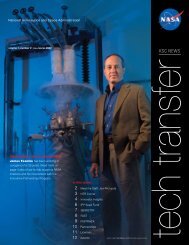2006-2007 - Kennedy Space Center Technology Transfer Office
2006-2007 - Kennedy Space Center Technology Transfer Office
2006-2007 - Kennedy Space Center Technology Transfer Office
- No tags were found...
Create successful ePaper yourself
Turn your PDF publications into a flip-book with our unique Google optimized e-Paper software.
Calibrating the Helium Pressurization System for the <strong>Space</strong> ShuttleLiquid-Hydrogen TankAnalysis of the results from the STS-114 tanking tests and subsequent launch calledHazardous-LeakDetection and into question existing thermal and mass models of helium pressurization of the liquidhydrogentank. This hydrogen tank, which makes up the bottom two-thirds of theIsolationExternal Tank, is pressurized prior to launch to avoid cavitation in the Shuttle MainEngine pumps. At about 2 minutes prior to launch, the main vent valve is closed, and pressurizedhelium flows into the tank ullage space to achieve set point pressure. As the helium gas cools, itspressure drops, calling for additional helium. Subsequent helium flows are provided in short, timedpulses. The number of pulses is taken as a rough leak indicator. An analysis of thermal models byMarshall <strong>Space</strong> Flight <strong>Center</strong> showed considerable uncertainty in the pressure-versus-time behaviorof the helium ullage space and the ability to predict the number of pulses normally expected.<strong>Kennedy</strong> <strong>Space</strong> <strong>Center</strong> proposed to calibrate the dime-sized orifice, which together with valves,controls the helium flow quantity (Figure 1). Pressure and temperature sensors were installed toprovide upstream and downstream measurements necessary to compute flow rate based on the orificedischarge coefficient. An assessment of flow testing with helium indicated an extremely costly use ofthis critical resource. In order to reduce costs, we proposed removing the orifices from each MobileLauncher Platform (MLP) and asking Colorado Engineering Experiment Station Inc. (CEESI) tocalibrate the flow. CEESI has a high-pressure air flow system with traceable flow meters capable ofhandling the large flow rates. However, literature research indicated that square-edged orifices ofsmall diameters often exhibit significant hysteresis and nonrepeatability in the vicinity of chokedor sonic flow. Fortunately, the MLP orifices behaved relatively well in testing (Figure 2). UsingFigure 1. The helium flow control oriface and associated instrumentation.72 Fluid System Technologies













